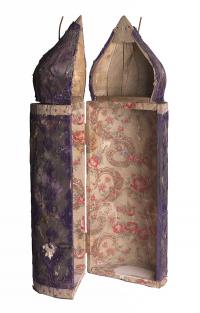Iraqi Jews lived in a land that was physically and culturally linked to the central sacred texts of Judaism. Babylonia in Ancient Mesopotamia (modern-day Iraq) is imbedded in biblical lore. According to Jewish tradition, the Garden of Eden was located in the fertile region between the Tigris and Euphrates Rivers. Iraqi Muslims and Iraqi Jews both revered local sites of tombs associated with biblical leaders and prophets, such as Daniel, Ezekiel, Ezra, and Jonah.
The Babylonian Talmud originated in this region. In the centuries after its compilation in the 5th century, it became the core text of Judaism combining traditional legal precedents, major Jewish concepts, and Jewish mores and practices. Renowned for their Jewish scholarship, the great 6th to 11th-century academies of Sura and Pumbedita elevated Babylonian rabbinic Judaism to become the dominant approach throughout the Jewish world.
Tik
In Jewish communities throughout the Middle East, the Torah scroll is generally housed in a rigid “tik,” or case made of wood or metal. Originally covered with velvet and metal ornamentation, this tik suffered damage in the flood water. The architectural form of this tik and most other Iraqi examples resembles the silhouette of Iraqi minaret towers.
Learn More

Bible: Writings Venice, 1568
Bible With Commentaries
This volume of the Hebrew Bible is one of the earliest printed books discovered in the Mukhabarat headquarters. Printed in late Renaissance era Venice by Giovannidi Gara, the central biblical text is surrounded by rabbinic commentaries. Of the close to 1,200 religious books recovered, approximately a quarter were printed in Baghdad,but others were imported from Hebrew presses worldwide—from India to Lithuania.
Learn More

Torah Scroll Drying Outside the Mukhabarat, June 2003
Torah Scroll
A Torah scroll contains the first five books of the Hebrew Bible (known as the Torah). As in ancient times, it is handwritten on parchment and cherished as an embodiment of the Divine word. Though no complete Torah scrolls were found, 48 Torah scroll fragments were recovered from the Mukhabarat basement. This fragment contains a text from Genesis.
Learn More

Babylonian Talmud Vienna, 1793
Babylonian Talmud
This volume of the Talmud discusses laws and topics relating to Yom Kippur, the Day of Atonement. On each page, the central talmudic text is surrounded by rabbinic commentaries and various indices and annotations.
Learn More

Baghdad, 1962 Sidur Kehilat Ya`akov (Community of Jacob Prayer Book)

Baghdad, 1912 Seder Minha ve-Arvit le-Shalosh Regalim (Festival Prayer Book)
Prayer Books
Beginning in 1862 and lasting more than 100 years, Baghdad’s Hebrew presses produced a variety of books, including liturgical works according to local customs.Over 400 prayer books and other liturgical texts were recovered from the Mukhabarat basement.
Left: Learn More
Right: Learn More

Kanun al Nisa (Laws for Women) by Yosef Hayim ben Elijah al-Hakam, the Ben Ish Hai Baghdad, 1906
Religious Guidebook
This religious guidebook for women, with various laws, prayers and ethics, is an Arabic text written in Hebrew letters (Judeo-Arabic). The primary daily language of Iraqi Jews was Arabic, spoken with a distinct Jewish dialect.
Learn More








